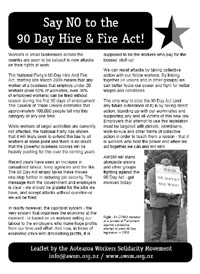 Download flier in .pdf format (198kb)
Download flier in .pdf format (198kb)
A flier produced by AWSM against the 90 Day Hire & Fire Act brought in by the New Zealand Government in late 2008.
Flier is formatted to be printed on double sided A5.
 Download flier in .pdf format (198kb)
Download flier in .pdf format (198kb)
A flier produced by AWSM against the 90 Day Hire & Fire Act brought in by the New Zealand Government in late 2008.
Flier is formatted to be printed on double sided A5.
The first issue of Solidarity, free monthly newssheet of the Aotearoa Workers Solidarity Movement. This issue has a special feature on water issues across Aotearoa / New Zealand. Some of the articles were written by me :)

Download a .pdf of the newssheet at http://www.awsm.org.nz/solidarity/issue1.pdf or read the articles online at http://awsm.org.nz/?p=78
Contents:
* Not our crisis! Resist attacks on workers
* Water meters for Wellington?
* Profile: Auckland Water Pressure Group
* He wai Maaori – Drinking water in Parihaka
* Say NO to the 90 Day Hire & Fire Act!
* AWSM Aims & Principles
The latest Israeli onslaught in Gaza has seen approximately 1,300 people in Gaza murdered, with 410 of them children. Approximately 5,300 Gazans were left injured. Meanwhile, Israeli casualties numbered 13 with approximately 518 wounded.
Gazan residents have long suffered from poverty (60% below the poverty line in 2001) and the resulting poor health – a study carried out by Johns Hopkins University (U.S.) and Al-Quds University (in Jerusalem) for CARE International in late 2002 found that 17.5% of children aged 6–59 months suffered from chronic malnutrition, while 53% of women of reproductive age and 44% of children were found to be anaemic.
Israeli and Hamas leaders seemingly agree on one thing – ordinary Gazans and Israelis must be made to bear the brunt of the attacks. There is mounting evidence that the IDF is following its senior partner, the US, in using white phosphorous as an offensive weapon in civilian areas. Banned under international law, white phosphorous munitions are chemical weapons with a pattern of splash damage similar to cluster bombs, but which spread blazing chunks of phosphorous and smoke laced with burning particles. The result is either death from suffocation or from severe burns, sometimes down to the bone. The IDF is responsible for herding civilians into a building before shelling it, killing scores of civilians in attacks on UN schools, shelling aid convoys, and destroying aid stockpiles during an attack on the UN headquarters in Gaza. Meanwhile, Hamas and other smaller groups in the Gaza Strip fired over 900 rockets and mortars into Israel, hitting homes, schools and synagogues in a number of towns and cities. While the weaponry available to Hamas is undoubtedly less accurate or devastating than that used by the Israeli military, the intent is the same – both sides are showing through their actions that mere residence in an area is enough to deserve attack.
During the recent Israeli attacks, Hamas leaders hid in bunkers while calling for ordinary Gazans to confront the militarily superior Israeli Army themselves, but most Gazans evidently attempted to do what was necessary to save their lives, by hiding or fleeing. Hamas reportedly prevented Gazans from crossing into Egypt for medical assistance, while Egyptian border guards fired warning shots to prevent refugees who breached the border themselves from crossing into Egypt.
While it is clear that the vast majority of the populations of both Israel and the Gaza Strip have received no benefit from this period of intensified conflict, the question must be asked as to who has. The governing parties of Israel, Kadimah (Forward) and Avodah (Labour), were facing electoral defeat (in Avodah’s case, virtual electoral oblivion) prior to this operation. Now, Avodah (who’s leader is Ehud Barak, the defence minister) looks like it will remain in government after the election on February 10, albeit with a new partner, the Likud Party. Hamas, meanwhile, has consolidated it’s grip on power in Gaza, and no doubt many of it’s allies will be licking their lips at the prospect of gaining a piece of the US$1 billion of reconstruction contracts being funded by Saudi Arabia.
One thing cannot be doubted – no matter who won the war, it is the working class of both Israel and Gaza that have paid the price in broken bodies and shattered lives.